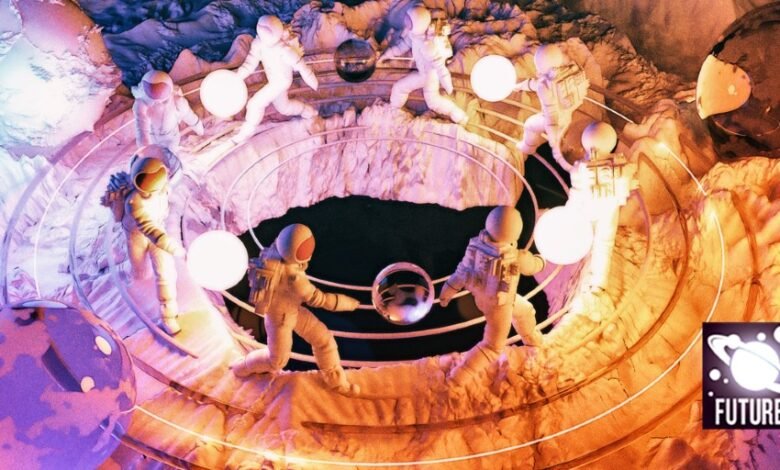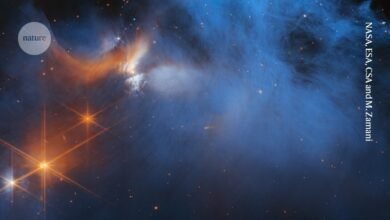
The frost was moving again. This time Declan Tornquist was sure of it. He’d been watching for days as the sunglow slowly brightened the horizon, the corona peeking higher (maybe), from one sleep cycle to the next. Hard to tell, because the horizon wasn’t smooth and the corona was forever changing.
But the frost knew. It knew when it warmed enough from its normal cryogenic cold to sublimate away, a bit like how, in a world he might or might not ever see again, the rising Sun melted a different type of frost off his lawn. It knew when the rocks cooled enough to allow it to redeposit. With the caveat that here, in the perpetual shadow of his new abode, true dawn would bring death if he ever let it come, and the frost was a mix of water, carbon dioxide and frozen nitrogen, each of which sublimated and deposited in its own way as the Sun crawled around the crater rim, once every 179 days.
Declan’s task was to follow the light and heat closely enough to keep from freezing but not so close as to overheat. He was Goldilocks, trying to find the perfect porridge. Too close to the sunlit zone slowly moving around the crater’s upper slopes on the side facing the Sun, and he and his electronics would fry. Too far back, and they’d freeze. In the middle, just right.
It should have been easy, but there was also an 88-day cycle, plus the libration. In eleven circuits, and he had never repeated the same path, rarely even seen his own tracks. He’d tried to program the navigation computer to find the best path, but it wasn’t designed for that. Not to mention the solar storms, which could drive enough heat into the corona to significantly alter the Goldilocks path. On Earth, solar flares produced auroras and interfered with communications. Here, they forced him to detour deeper into the crater as he slowly circled its shadowed realms, seeking the optimum path … until they abated, and he had to climb back, closer to the heat that gave both life and death.
The reality was, the frost knew best. If he got too far from the heat, it would deposit on the windows of his mobile hab. Too close, and it would recede. It was a better gauge of the ideal route than anything he’d been able to get from the NavComp.
Not that following the frost had been his original mission. Mercury was, by most measures, the most inhospitable place in the Solar System, so hot that direct sunlight would not just cook a human body, but incinerate half the critical components of his lander.
Read more science fiction from Nature Futures
But it was also one of the Solar System’s potentially most habitable outposts because it had craters at its poles whose floors had not seen sunlight in billions of years. Colder even than Pluto, they formed ice traps that had collected volatiles from billions of years of comet impacts into frozen deposits that contained everything needed to establish a permanent base on the closest planet to the Sun. Assuming you could survive the trip to get there. Assuming you could find a way home again.
Assuming, assuming, assuming.
Which is why this trip had been Declan’s, because he was the one they thought could do it. Because his psych profile said he might survive it. Three years of whirligiging around the Solar System, circling in for a landing. Three years of melting ice to create fuel for the return. Three more years of whirligiging back to Earth. Nine years alone, long enough to set a record few would be willing to challenge.
Until it went wrong.
Declan’s lander had come down fine. One of the reasons they’d chosen this crater was that at 112 kilometres across, it was hard to miss. But Delcan’s craft was the only part of the mission with a human pilot. There had also been a robotic lander, designed to come down near the rim of the crater, where, instead of the perpetual dark below, there was perpetual sunlight. Built of the type of heat-resistant material previously used by close-in solar probes, it would deploy an array of mirror-bright panels to focus sunlight on a third lander, which would set up a power plant to convert ice collected by Declan into rocket fuel for his return to Earth.
Which would have worked, had not the mirror-deploying lander come down on a boulder and wound up on its side. Why this happened was the source of endless debate, Earthside, but for Declan, it was a lot simpler. His mobile hab wasn’t designed to live indefinitely at the bottom of a crater whose temperatures were below the freezing point of the oxygen he needed for survival. It had been designed under the assumption he would collect ice in the cold and dark, carry it to the fuel-processing lander, warm up during the hand-off, then move away before overheating.
Without periodic forays to the focus of the heat from the second lander’s mirrors, he needed warmer climes before his mobile hab ran out of the ability to cope. That meant climbing up out of the perpetual dark, then following the Goldilocks zone behind the life-or-death-dealing sunlight streaming across from the far side of the crater. It was like trying to chase the perfect October day without getting too close to either August or January.
A 112-kilometre crater has a circumference of 350 kilometres. That meant that all that Declan’s mobile hab had to do to stay in the Goldilocks zone was maintain a pace of about 2 kilometres a day.
On Earth, you can easily walk that in an hour, even on uneven ground. Walk an hour, rest 23 hours. What could be simpler? And Declan didn’t need to walk. All he needed to do was drive. Until …
How long did NASA’s Perseverance rover go? Or Curiosity? NASA built things to last, and although Declan’s mobile hab had components from half a dozen other space agencies, the same principles applied. These things lasted. Until they didn’t. Everything sent into space eventually fails, but by then, Declan was supposed to have been long on his way back to Earth.
Which now wasn’t going to happen. What came when the mobile hab was no longer mobile enough to keep up with the Goldilocks zone, even at 2 kilometres a day? It was, of course, something he’d been thinking about since the first time he’d realized that his life depended on 2 kilometres per day. What if this breaks? What if that breaks? That type of questioning is reflexive to anyone driven to explore beyond an easy hike.
When the mobile hab ultimately failed, enough of its critical equipment was sufficiently portable in the low Mercurian gravity that he could bundle it up, suit up, and carry it or drag it on a travois he’d long ago figured out how to construct. That included the power source that helped to convert sweat, exhaled CO2, and other less-mentionable waste products (plus a few scoops of ice) into food and water that, if not exciting, would sustain him indefinitely, so long as he stayed close enough to the Goldilocks zone for it all to keep working.
Two kilometres a day. He’d once read of a guy who’d got some kind of record by running at least a mile — not all that different from 2 kilometres — every day, for 50 years. Streakers, that’s what they call such people. Which is cool, if it’s a sport. Doing it because your life depends on it, forever? Collecting data each day to beam back for future explorers, while hoping that maybe someday, one of them will come to rescue you?
Once upon a time, when he was young, Declan ran a marathon. He wasn’t fast, but neither did he falter. Two kilometres a day. He could do that. So long as he kept track of the frost. Because the frost knew.
Source link





